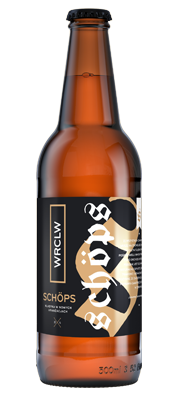Browar Stu Mostów has recreated a historical beer style brewed under the Wrocław brand over 500 years ago. Brewed since the mid-16th century in Wrocław, Schöps (ram) brought the city fame and prestige that went beyond the Silesia region and lasted for over two centuries. Considered the leading beer in this part of the Old Continent, Schops was mentioned for the first time in 1553 when the city council of Brzeg banned its delivery. Most probably Schöps had been brewed a few decades earlier as different sources cite the appreciation of “the beer from Wrocław” in numerous towns of Silesia in the first half of the 16th century. It also stirred interest on the science and cultural scene of the city.
Today the forsaken recipe has been brought back thanks to the commitment of historians, brewmasters and brewers from world over. The aim of the project is to recreate a beer style that disappeared from Wrocław pubs for over 2 centuries.
Style
The wheat symbol of Wrocław brewed as early as in the 16th century, Schöps was considered to be one of the leading beers in Europe at that time. The history of the beer vanished two centuries later with no recipe being preserved till this day. Together with an international team of experts, we’ve ventured to recreate the style based on chronicle entries regarding its taste and the available knowledge on traditional brewing methods in the Lower Silesia region. The beer was of unique honey-nutmeg flavour. As it might not have been too hoppy, the beer’s sweetness could have been balanced with slight acidity coming from lactic acid bacteria living in the oak barrels used for fermentation and ageing processes.
Malts/extract:
The majority of wheat malts used in the production of the beer account for its honey- nutmeg aroma. We have used over 80% of light, dark and chocolate wheat malts to recreate the flavour of the previously brewed beer. The caramel and melanoid barley malts have been added to achieve the fullness and enrich wheat malt aromas. The exclusive taste has been achieved thanks to as many as 7 malt types as well as the traditional decoction mashing based on separating and boiling part of the mash. Since Schöps was considered to be a stronger beer, we have raised extract to 14.5%. The beer was known to be slightly lighter than the German Bockbier. Still, alcohol extract is quite low thanks to high fermentation yeast strain that is of low attenuation level, which accounts for the beer’s maltiness.
Hops:
Schöps might not have been a particularly hoppy beer style. The hops used for its production most probably were local. One of the oldest Polish hop varieties, the Nowotomysky hop variety, is not available in large quantities yet, although its reintroduction is in progress. For this reason, we’ve used a direct follower: the Lomik hop variety that is of traditional herbal-flowery aroma and low bitterness level.
Bacteria:
Schöps was never purposefully cultured with lactic acid bacteria. The thermophilic bacteria strains simply lived in the oak barrels used for beer fermentation and ageing. The slight acidity balanced high maltiness of the Wrocław-based Schöps. The acidity also affected longevity of the beer as fermentation is a natural food preserving process. In order to achieve this result, we have added so-called “sauergut”, or wort cultured with lactic acid bacteria. The following bacteria that are common in bread starters, kefirs and yoghurts have been used: Lactobacillus lactis, Lactococcus lactis, Lactobacillus plantarum, Lactobacillus delbrueckii subsp. Bulgaricus.
- Style: Schops
- Parameters
- Extract: 14,5 %
- Alcohol: 4,3 %
- IBU: 15
- Ingredients:
- Wheat malt; barley malts: Pilsner, caramel hell; caramel red; melanoid, chocolate wheat malt
- Hops:
- Bitter: Lomik (PL)
- Yeast: Empire Ale M15 Mangrove Jack’s
- Bacteria: Lactobacillus lactis, Lactococcus lactis, Lactobacillus plantarum, Lactobacillus delbrueckii ssp. bulgaricus
- Look: cloudy, dark
- Aromas: nutmeg, honey, slightly roasted yeast dough; dry apricot
- Mouthfeel:
-
- full, malty
- honey-nutmeg
- slightly acid, sweet and sour finish
- Serving temperature: 5-8C
- Glass: Weizen
- Foodpairing:- Wrocław stew; venison served with Wrocław gnocchi; cumin-flavoured sausage; cheeses: Sudecki-type cheese, Łomnicki-type goat cheese; desserts: yeast dough with cinnamon crumble



